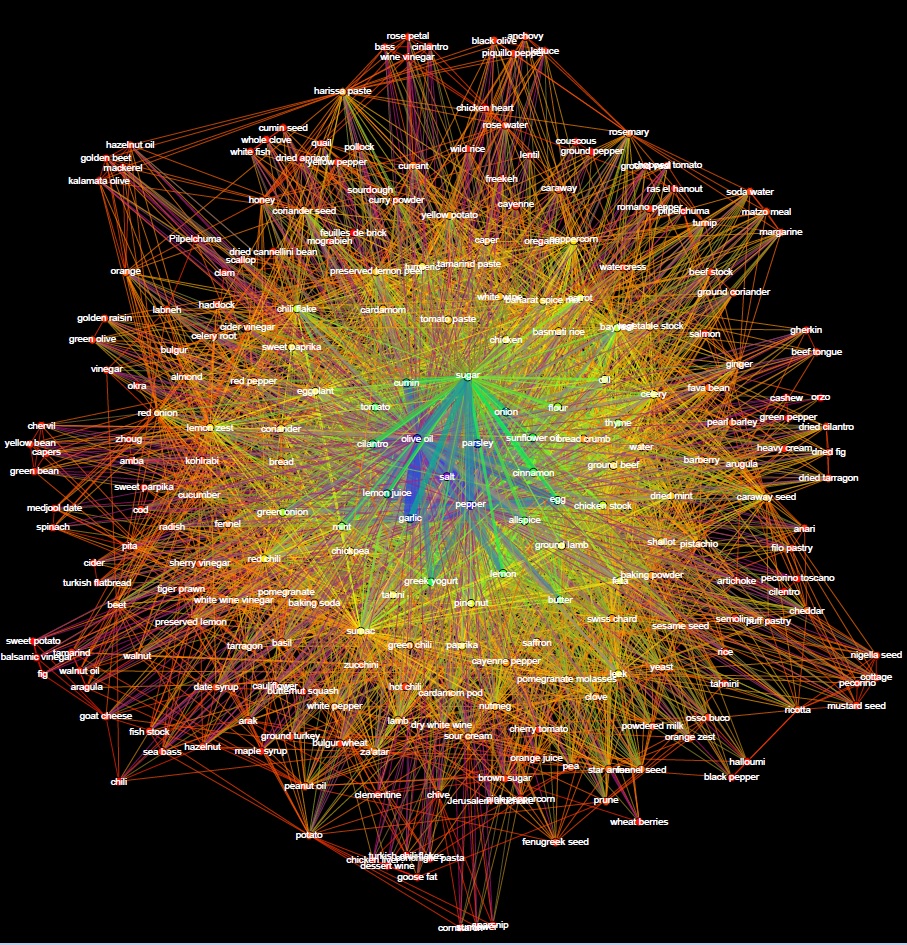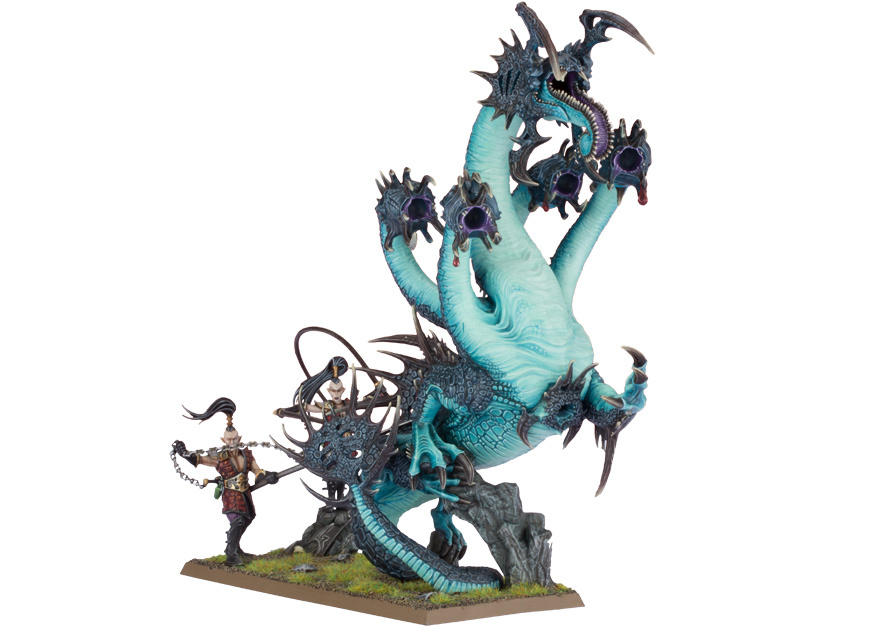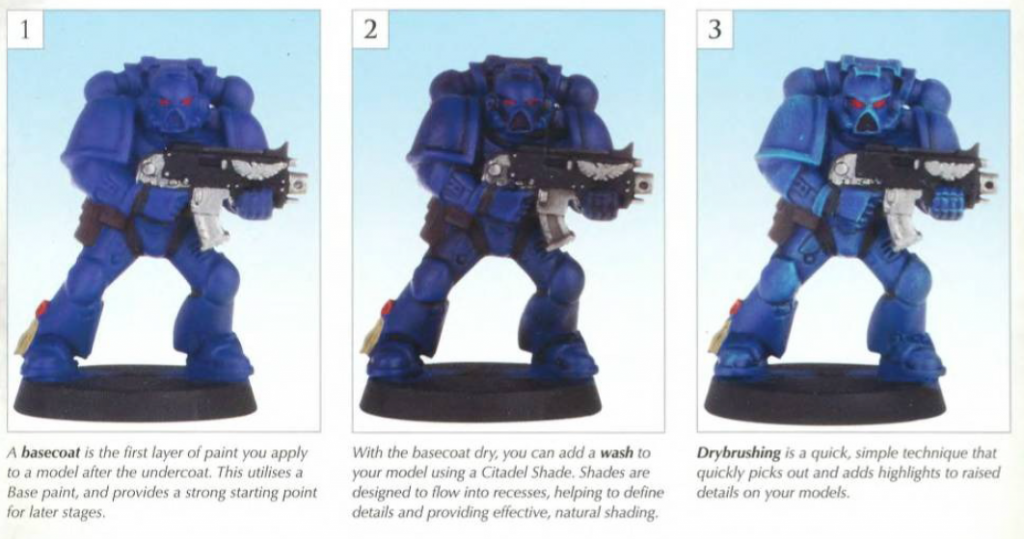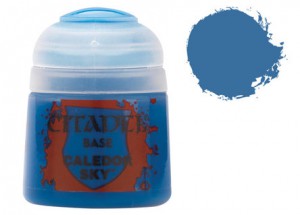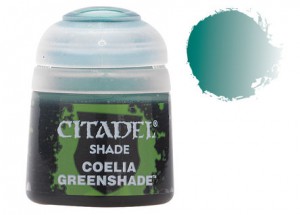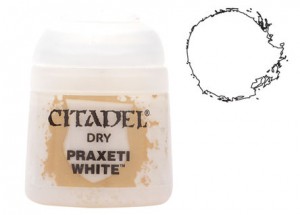The post Boot Camp: Networks Jerusalem Cook Book appeared first on &.
]]>I set out to map Jerusalem’s cultural sectors through the relationships between its culinary ingredients. The thought, absurd as it might seem, was planted in my brain when I came across a famous adaptation of the 1581 Bünting Clover Leaf wood cut. Near Jerusalem’s Municipal complex, in Safra Square, Arman Darian’s tiles position Jerusalem at the meeting point of Africa, Asian and Europe. Despite its “unscientific” representation, the politics of this map are made apparent in its suggested geography. Given its discordant populations and its position as a trading hub, it seemed feasible that ingredients would cluster and, in so doing, point to histories of international trade, colonialism and cultural isolationism.
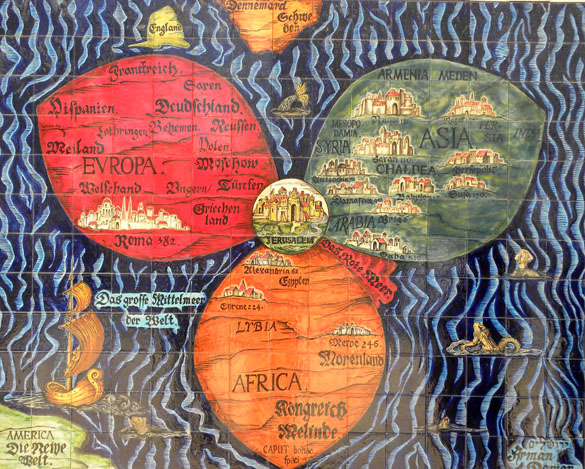
Arman Darian’s map of Jerusalem in Safra Square
I produced a network diagram of data pulled from Yotam Ottolenghi and Sami Tamimi’s cookbook, Jerusalem. Co-authored by ex-patriots of Jewish and Arab sectors respectively, Ottolenghi and Tamimi’s work has been received with surprising acclaim. The New York Times writes,
“American food lovers are not only cooking from “Jerusalem”; many of them are cooking their way through it, as cooks did with “Mastering the Art of French Cooking” in the 1960s and with “The Silver Palate Cookbook” in the 1980s. “Jerusalem” is the first book in recent memory to join that group, and the first to do it via social media, as well as old-fashioned word of mouth.” (Julia Moskin Jerusalem’ Has All The Right Ingredients)
I strategically chose such an influential work, so that at the very worst I would be offering an interpretation of a culturally salient fiction of Jerusalem’s cuisine.
The software I used is called Gephi. It is an open source data visualization tool. My goal was hopefully simple, create a node for each ingredient and draw an edge between them each time they appeared in the same recipe. I hypothesized that the resulting network would be bifurcated, as Sephardic Jewish recipes gravitated to a set of clustered ingredients on one side, and Arab ones to the other.
My first attempt to manually insert recipes directly into the program produced uninteresting graphs, cluttered by the presence of recipe nodes, rather than connecting ingredients to each other. Appealing to Gephi’s online forums, a user pointed me to their plug-in which allowed me to re-enter data efficiently, effectively allowing me to produce what I imagined possible. It took me several hours of combing for patterns before I admitted I was wrong. Jerusalem’s recipes are not divided cleanly into cultural lineages. Classical North African ingredients such as feuilles de brick and preserved lemons sit next to South Asian spices such as turmeric and cardamom. Underrepresented as they might be, even Ashkenazi (Eastern European) Jewish staples such as matzo meal, are shifted next to basmati rice and the Sephardic spice mix, ras el hanout.
Ottolenghi and Tamimi predict my results in their introduction, explaining, “in this soup of a city it is completely impossible to find out who invented this delicacy and who brought that one with them. The food cultures are mashed and fused together in a way that is impossible to unravel. They interact all the time and influence one another constantly, so nothing is pure anymore” (Ottolenghi & Tamimi 2012).
The post Boot Camp: Networks Jerusalem Cook Book appeared first on &.
]]>The post Painting by Viscosities appeared first on &.
]]>MacLuhan’s perennial aphorism “the medium is the message” has me thinking about acrylic polymers. These are the literal media that hold in suspension the pigments of certain painters. This is true of my own pigments, for I am a table-top miniature painter, who participates in a multifaceted hobby of strategy gaming and fiction-making called Warhammer Fantasy Battle (WHFB). These miniatures are produced by Games-Workshop (GW), which defines itself as the world’s premier miniature selling company. In addition to deploying cutting edge machines and hiring expert sculptors to make a technically superior product, GW deploys multiple strategies to stabilize demand. Firstly, it has created an extensive rulebook which can be followed with a set of miniatures to produce interesting strategic gameplay. Secondly, as a form of trans-media storytelling, it has commissioned an extensive body of fiction which refers back to the modelled miniatures. Thirdly, and this is where my analysis centres itself, it has created a line of paints and techniques for collectors to use on their miniatures in order to increase their representational fidelity to a fictional world.
While it does promote a standard appearance for its models by featuring its own painting team ‘Eavy Metal on the boxes of its models and in the issues of its magazine, White Dwarf, GW is acutely aware that this is not enough. Given that fewer people know how to paint than play strategy games, and that GW’s “curb appeal” is contingent upon its players having well painted models, it is necessary for GW to automate people into producing paint jobs that they will find adequate. Because GW needs to sell a lot of models to make a profit, it has built a game system which requires between 100 and 300 models to play. Given that these models are expected to be painted, it is in GW best interest to develop and share techniques that enable speed painting. Simply put, the faster you can finish painting your models, the faster you can consider buying more. It does so in a two-pronged fashion, it promotes a technique of painting through its in-store customer service which works in tandem with a set of acrylics to produce what it calls the Citadel Paint System. This probe will explore the ways in which the paints have agency, the reasons for why they do, and what they teach us.
To do so, I turn to Ian Bogost’s philosophical carpenter who practices Object Oriented Ontology (OOO). He explains that she “creates a machine that tries to replicate the unit operation of another’s experience. … [T]he alien phenomenologist’s carpentry seeks to capture and characterize an experience it can never fully understand, offering a rendering satisfactory enough to allow the artifact’s operator to gain some insight into an alien thing’s experience” (100). Essentially, Bogost’s argument is that there are multiple ways of expressing things and that these modes of expression shape what can be expressed. This carpenter is capable of expressing ideas outside of language with the use of her craft’s materials. This matters because she is able to produce specific kinds of knowledge, which would otherwise escape the philosopher afforded by the materials of the essay. For his and our benefit, Bogost cites Bruno Latour, “Standing by what is written on a sheet of paper alone is a risky trade. However this trade is no more miraculous than that of the painter, the seaman, the tightrope walker, or the banker” Knowledge, he concludes, “does not exist. . . . Despite all claims to the contrary, crafts hold the key to knowledge” (110). As a painter and craftsman then, I would like to explain why people do not naturally paint miniatures well and what kinds of knowledge they receive from the materiality of Citadel Paints.
In order to paint a miniature, one must first prime it with spray paint. Spray paint can adhere to the plastic, resin and pewter that the models are made of, and can itself be adhered to by acrylic. Because the spray paint is usually a not meant to colour, GW recommends base coating. The Base paint “Caledor Sky” is one of the many available base coat colors. These paints are meant to go on the model first because they cover evenly and thickly, hiding the underlying primer of the model. The reason these paints can do this is because they have a very high pigment density. This high density lends a chalky look to the paint and will rarely work as a final color. However, this is not the only problem, if one were to quit painting after applying a Base paint to every different part of a model, something would look wrong.
It turns out that the models are at a scale shadows and highlights do not appear natural with normal levels of lighting. The recesses and edges of the miniature need to be accentuated. It also turns out that manually painting changes in light is very difficult. Miniatures are small to begin with, but their recesses and edges are measured in half millimeters. To freehand paint these would require tremendous skill with even the finest of brushes. What is more, it is not obvious where shadows live and what receives the most light. In order to create the effects of shadow without requiring years of training steady hands and accurate eyes, Citadel offers Shade paints, such as “Coelia Greenshade.” These have very low levels of pigment in a particularly viscous acrylic. The increased viscosity of the acrylic makes is so that the paint will pool in crevices due to its surface tension and the phenomenon of capillary action. Because of its low pigment density, what little amounts that do not pool, barely show. What this means for the miniature painter is that by slathering a Shade to a model, all of the recesses will receive paint while all of the edges and tips will remain brightly coloured. The end result is a shaded model produced with technique, but not trained skill. What is more, the viscous acrylic returns a shine to the model, repairing the previous chalkiness. It is here that GW has communicated how shadows behave and it has done so with an acrylic machine. It is not a one-to-one correlation, but an expression with certain abstraction, which is nevertheless accurate to a degree. Shadows pool, they are like fluids which form capillary action and flow into the smallest crevices with alacrity.
To produce highlights, the opposite of shadows, Citadel offers Dry paints such as “Praxeti White.” These are extremely high pigment paints with a barely fluid acrylic. When a brush is dipped in these, paint does not come off normally. The pigment is dried onto the bristles and will only come off if a pigment-covered bristle scrapes against a sharp surface. To highlight a model then, it is only a matter of roughly and briskly moving a paintbrush covered in a brightly coloured Dry paint over a model. Here again, we learn how light behaves by experiences how paint behaves. GW has made it so that in a coat of spray paint, a base coat, a shade and dry brush, applied haphazardly to a miniature design with this process in mind, produces an attractive model. The process of painting is Taylorised allowing unskilled labour to mass produce painted models. Despite this alienating mode of unpaid labour, which replaces artistry with machines in order to stabilize a network of demand, we can treat this machine as an object which expresses objectness and learn about ourselves.
Our visual senses are keenly aware of shadows and highlights, and that their accentuation in small objects makes them look more meaningful. Graham Harman writes,
“Real objects exist in themselves, regardless of whether anything else registers their existence. But content is always content for some entity. Normally we do not notice this in our own lives, since we take ourselves for granted and assume that merely by opening our eyes we see everything exactly as it is. We are normally unaware of the contortions imposed on the things by our own limitations and even our own gifts. For this reason, we do not usually experience the tension between ourselves and our experiences, any more than we usually notice the tension between an apple and its real or sensual qualities. For this to happen, we need to endure a breakdown of the usual situation in which perceptions and meanings simply lie before us as obvious facts…” (258).
When I first began painting, I did not have the time or money to paint my models the ways GW proposes. I used dollar store acrylics and dollar store brushes. My models were alien in appearance as they appeared nothing like I imagined they would. They were the wrong texture, tone, and served as a reminder of my own inadequacies as a painter. Despite this, I happily played with them until I experimented with the Citadel Paint System. The results of my labour with these tailored materials were so far beyond what I had been producing that I eventually had to sell my early models for they embarrassed me too much. In exchange for freedom of hand and mind, I better understood how light behaves, how I take it for granted and why, where, and when it changes colours.
Works Cited:
Bogost, Ian. “Carpentry.” Alien Phenomenology, or, What It’s Like to Be a Thing.Posthumanities. Minneapolis: University of Minnesota Press, 2012. Print. 85–111.
Harman, Graham. Selections from Weird Realism: Lovecraft and Philosophy. Winchester/Washington: Zero Books, 2012.
The post Painting by Viscosities appeared first on &.
]]>The post 31-8-13 #digra appeared first on &.
]]>@DangerWillRobin. Before arriving at DiGRA one week ago, I tweeted about once per month on average. I had 65 followers and followed a similar number.
Now: 102 followers with 75 more tweets. While I can admit that I went a little twitter crazy, I did not crack the top 10 for freq. in conf. tweeters. #win
Twitter acted as a communal space for talking about upcoming presentations, spreading the content of current presentations to those in different tracks,
sharing jokes, and complaining about the conference’s organization. While I deployed my account in all these ways, what kept me posted/ing was deep seated FOMO
(which by the way, got an Oxford definition during the conference). With over 200 presenters, and only 3 days, one could at best get to 15% of all talks.
Now this would have been fine if abstracts were tied to names/places, but the schedule only offered titles of papers (hence one of the complaining tracks on Twitter).
Unfortunately, I made some bad choices and missed some twitter trending talks. While I would sit trapped in a room listening to a paper that barely interested me,
I would tweet about its contents and excitedly read about other people’s lectures via live twitter coverage. @daniel_joseph
Unfortunately, twitter allows for an obnoxiously small amount of characters when one is trying to offer philosophical insight in an academic context.
To anyone who thinks they can go to #digra, or even #cgsa without twitter, I would urge them to reconsider.
The hybridity of anonymity and fame which is offered leads to a kind of political honesty that can get just about anyone noticed. #scandals
In the end I was pretty pleased by this new mode of living, constantly listening to the real world, writing about it and tweeting about it so other people can do the same
but I was pleased as punch when @ibogost started following me. Now I can talk to the person I cite casually about stuff.
Image credit: School for Bird, Teachability.com
The post 31-8-13 #digra appeared first on &.
]]>The post 23-8-2013 How To Play Well, Even If It Means Winning appeared first on &.
]]>This week I have been preparing for my Digital Games Research Association conference presentation. I will be talking about procedural rhetoric and the social contexts in which it breaks down. I originally submitted several months ago with the idea to discuss my board game Gets it Better and the ways in which it constructs situations in which players must betray one another. Thank goodness I was given an opportunity to reassess my abstract. The work itself has gone through some changes, and there have been an abundance of playtests which make for worthwhile a set of anecdotes to tell. The talk I am going to give will be a reshaped presentation which I gave at the Canadian Game Studies Association Conference. Since my abstract was submitted originally, the game has been overhauled and showcased, most recently at Vector and Videofag’s Queer Arcade. The final version has been completed with 10 beautifully bound rule books acting as art objects, a few of which I plan to bring with me.
The topic of discussion for the presentation centers on the idea that games might present goals which are undesirable to attain for non-lusory reasons, but that getting past their undesirability might have unforeseen payoffs. In the case of my game, it is often optimal to commit suicide, given how the victory conditions are stipulated. This was a conscious design decision meant to represent an understanding of existence which is limited to high school. Dan Savage’s campaign to inform homosexual youths that “It Gets Better” (meaning after high school), is an attempt to curb unhappiness and suicide by convincing people that there is an extended period of life worth experiencing after the age of 18. By constructing a representation of high school which only values total happiness at graduation, without valuing the potential amount of happiness thereafter, it only makes sense that players will find reasons to end their play sessions, should they accumulate negative happiness modifiers (e.g. bullies and guilt). Should players attempt to stay alive, even though it is in the best interest in the game to die, they will produce situations which I argue are worthwhile to explore from a game studies standpoint, particularly with respect to procedural rhetoric.
Right now, I am catching up on my reading for the literature review I have been working on for the past few months, particularly where there is overlap between game theory and literature. Dr. Wershler clued me into an old issue of Yale French Studies (1968: 41) which appears to be invaluable and under cited in game studies.
The post 23-8-2013 How To Play Well, Even If It Means Winning appeared first on &.
]]>The post 23-7-2013 Board Games for Learning appeared first on &.
]]>On Thursday I hosted three French scholars from Lyon. Somehow they knew I was involved in serious games, board games in particular, and invited me to their serious games Facebook group. David Vallat, my primary contact among them, told me very little about himself, other than his interest in using games as a didactic tool at the university level. When he announced that he was coming to Montreal, I offered to give him a tour of Concordia (starting at the Myriad department).
He came with two colleagues (one being his wife) and son. We sat down and I asked about their work. I was completely blindsided by the fact that they were educators in a marketing department (HR, Economics and Marketing being their specialty). I assumed they were in education or the humanities. I then was shocked to discover that they were using Eurogames to teach strategy and competition. Here I was, planning on showing them the state of game studies at Concordia, when really they were after something quite a bit different. Regardless, they signaled that they were keen to hear about our work in games and had already visited Universite de Montreal and UQAM.
Firstly, the fact that I was working multidisciplinarily was unheard of to them. Not that they objected, in fact they seemed please to know that some people mix communications, sociology and English together. Second, they were surprised to hear that students were interested in studying games for the sake of learning and not to get a specific job. So much so that they recorded me saying students come to study the humanities to improve their capacity to think and write deeply and creatively and that these are the skills demanded by the 21st century. Specifically, when teaching game studies, students can begin to think about systems, their biases and modes of critiquing them. And finally, the fact that we had university support to the point of having three lab spaces dedicated to games studies and an incubator for the public good was flabbergasting.
I showed them my board game, Gets it Better, which is going on exhibition next week. I took them to the Critical Hit play test, which was well attended and showed off some very cool WsIP and introduced them to Jason Begy, who solved their most pressing problem: are their deep strategy games themed by the fashion industry? The answer is yes, “Pret-a-Porter”. Apparently they were having a hard time interesting their female students with the thematics that normally come packaged in board games.
The post 23-7-2013 Board Games for Learning appeared first on &.
]]>The post FreezeTag Conference Planning appeared first on &.
]]>My co-authored book chapter with Renée Jackson and Dr. Bart Simon, titled “Gleaning Strategies for Knowledge Sharing and Collective Assessment in the Art Classroom from the Videogame Little Big Planet’s Creator Spotlights,” has been accepted with minor revisions for an upcoming book entitled Educational, Behavioral, and Psychological Considerations in
Niche Online Communities. Needless to say, I am now at work on said minor revisions and looking to get rights to use screenshots in the book.
Most of the week, however, has been spent on a proposal for the Center for Technoculture, Art and Games. Skot Deeming, Kalervo Sinervo, Allison Kyran Cole and myself have been working together to design an interesting conference concept, call for papers and schedule (along with a budget). Our working title is FreezeTag, given the projected time of year, the center’s acronym and game studies focus of the conference. More specifically within game studies, we are hoping to focus on art games and the theory of it. The angle I am gunning for is one of hybrid panels where scholars and artists alternate giving presentations. With Skot’s expertise in video game curating, I am confident that we will pair the conference with a great art game exhibit.
Finally, I have been working on the literature review, which has turned it focus to proceduralism and its detractors. I am done reading Bogost and Sicart, and am onto less famous game scholars. My major fear is that we are once again repeating the straw men debates of ludology and narratology.
The post FreezeTag Conference Planning appeared first on &.
]]>The post 2013-06-27 Digital DIY and a Paper That Won’t Die appeared first on &.
]]>This week I submitted an abstract to a special issue journal of Communication, Capitalism and Critique. Dr. Bart Simon and I have been working on this paper for too long now and are coming to terms with imperfection. Co-authoring over a back and forth on the same document for span of effectively 4 months of writing is a surreal experience. Looking back at the document, no sentence appears to be authored by either of us as we have restructured, re-imagined or otherwise re-emphasized each paragraph a half-dozen times.
This was for all intents and purposes my first attempt at interdisciplinarity as Bart had me don the caps of Marxist and sociologist while defending my own fedora of a philosophy. The result was a tidy little paper titled “Digital DIY: Craft and Creative Labour in Little Big Planet.” We addressed critical Marxist media theory which has renewed critique of game cultures such the work of Nick Dyer-Witheford and Greig de Peuter (2010). Our goal was to counter the general feeling that players were being exploited wholesale by using level editors to create content for games. We began our argument from David Hesmondhalgh’s (2010) concern for amateur coaching, which while unpaid provides deep emotional forms of reward. From there we drew from interview data, community forums and analytic aesthetic philosophy to build a case for labour which is self-fulfilling because it is intrinsically valuable.
In addition to finagling an abstract for said essay, I was continuing work on my game studies lit review. The process felt off somehow as it seemed I was building an encyclopedia of classic game studies terms: Magic Circle; Paidia; Ludus; Agon-Alea-Mimicry-Ilinx; Lusory Attitude; Ludology; etc. The worst part is that I feel these terms are mostly valueless, given their weak analytic constructions. (Except of course for Bernard Suits’s who’s definition of games reinvigorates me every time I read it). Luckily, Level 1 game studies lit review construction will be over soon and I can get into the more contemporary debates on procedural rhetoric and player narratives.
The post 2013-06-27 Digital DIY and a Paper That Won’t Die appeared first on &.
]]>The post 2013-06-22 From Archivist to Curator appeared first on &.
]]>For the past two days I have been attending sessions at The International History of Games Conference. While this has run some serious interference on my literature review (see below), it has been a valuable academic culture shock. The majority of papers presented do not seem to care about politics or power. The goal of much of the research is strict discovery and textual preservation in the mode of archiving. In response, many audience members simply stroll up to the microphone at question period and ask “Why do you care?” “Why does this matter?” and “Where is the analysis?” These questions, which I found my internal mental-self asking, are barely answered. What is worse, they make me question my current work creating a literature review.
I have been awarded the Renaud Teaching Assistantship to produce course materials. In my case, these have taken the form of a document I am calling “Theories of Narrative in Game Studies.” While I was planning it out, I had inadvertently produced some kind of arbitrary selection of disjointed papers representing a history of game studies, planning to describe them summarily for the sake of archiving. Now I am looking at my project in a new light, and not a moment too soon as the deadline is a week away.
Informed by a second set of panellists, Cindy Poremba, Chris Romero and Kristin MacDonough, whose work was not so focused on the archive, but its curation, I am moving towards some kind of poetically informed literature review. Instead of generating a set of data points, I want to showcase a series or collection of works which speak to and against each other to create meaning through juxtaposition. In exchange for the pretense of any scientific or objective accuracy, I am hoping to provide meaning. Whether or not I am clever enough to deliver is something next weeknotes will have to cover.
The post 2013-06-22 From Archivist to Curator appeared first on &.
]]>The post 2013-06-12 The Newbies Are Coming appeared first on &.
]]>I have just moved into the M Lab, I think I was the first one, but now I see Dr. Consalvo’s computer sitting comfortably in the corner. I am surrounded by thousands of dollars in PC video gaming equipment and feeling jealous of the Critical Hit Incubator’s resources. Having just returned from the Japan Game Studies Conference and the Canadian Game Studies Conference, I have been sizing up my duties as a PhD student. As it stands, I have come to terms with the fact that I need to represent myself better (detailed and frequent), which is why I have assented to this intriguing weeknote format. Hopefully I will be able to structure a coherent self over the next 208 weeks of my doctorate with these blog entries aiding my identity formation. That said, I want to talk about all the amazing people I have been hanging out with who are about to be heavily involved with video game research at Concordia.
Yesterday, I bumped into an old friend and long time board gaming partner Rainforest Scully Baker, who tells me he has won an undergraduate research assistantship and is working with Mia on speed running culture all summer. I sat and watched him play Sonic Adventure 2 on the Dreamcast for an hour as he repeatedly failed to beat his previous best times. Hopefully he will come do a game studies M.A. in Fall 2014.
Speaking of game studies M.A.s, two days ago I met up with Pierson Browne, who is coming to do his M.A. in the Fall. We both audited Pippin Barr’s course on game design, where Pippin told us about his attempts to publish a new iPhone game which subverts control schemes to make people look ridiculous while playing on metro. Pierson is going to be working on representations of nuclear arms in games with Mia.
Six days ago, I hung out with Skot Deeming in Victoria. He presented after me on his curatorial practice in Toronto. We talked about Queer Arcade and getting my work “Get’s It Better: Poor, Ugly, Gay, Stupid, Sick” through the challenges of being a board game in a museum space (possibly the worst way to exhibit board games to be honest). He’s coming to do his Doctorate in game studies in the Fall.
So yeah, needless to say, I am extremely hyped for whats to come with all the awesome people getting involved in games at Concordia.
The post 2013-06-12 The Newbies Are Coming appeared first on &.
]]>